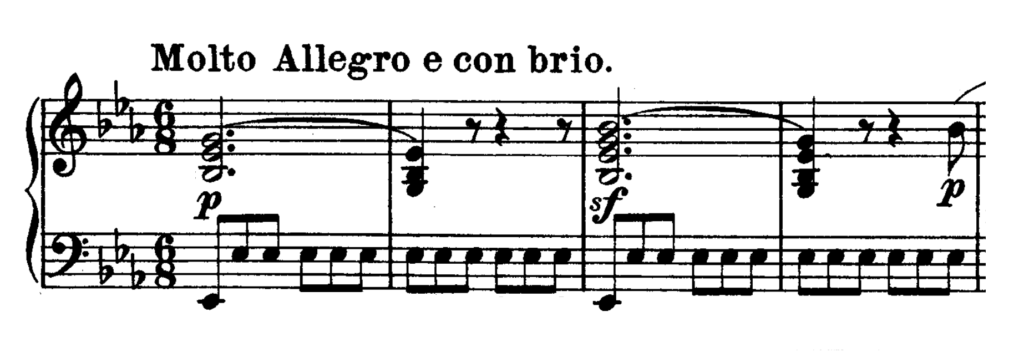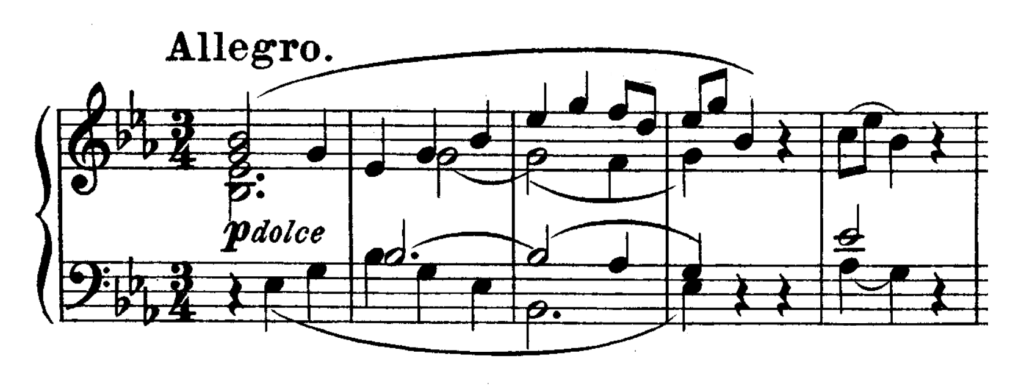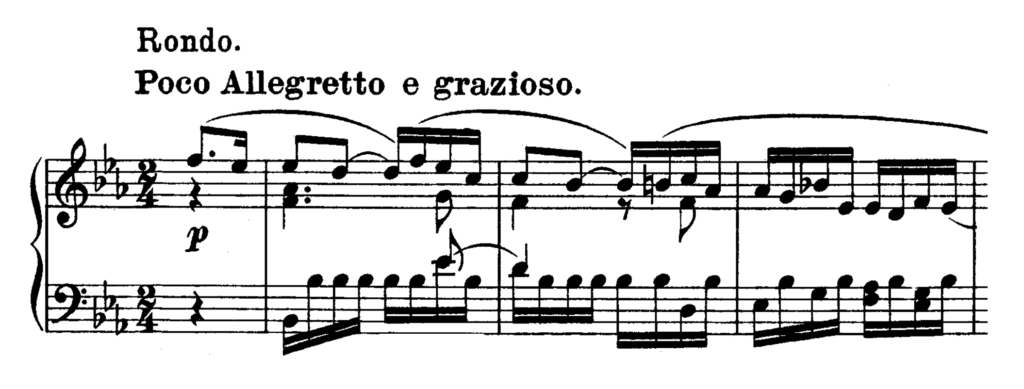Analysis
Contents
For the benefit of all pianists learning this work, we present to you a concise and easy to use analysis of Beethoven’s Piano Sonata No.4 in Eb major.
First Movement (Allegro Molto E Con Brio )
Form: Sonata Form. Eb major.
EXPOSITION:
Bars 1-17: First Subject in E flat major (tonic). The first subject is constructed on two distinct figures, Bars 1-2 and 5-6. It ends with a full close on the tonic, Bar 17.
Bars 17-41: Connecting episode. The connecting episode commences with a four-bar passage, Bars 17-20, which appears inverted, Bars 21-24. It ends on pedal point.
Bars 41-127: Second Subject in B flat major. The second subject may be divided into four parts, all in the key of the dominant: first par, Bars 41-59; second part, Bars 59-93; third part, Bars 93-111; fourth part, Bars 111-127. The last is entirely constructed on dominant pedal point.
Bars 127-136: Coda. The Coda consists of two bars (127-128) repeated (varied) three times in succession, simply confirming the perfect cadence.
Double bar and repeat.
DEVELOPMENT:
Bars 137-188: The development contains references to the first subject, the connecting episode figure, bars 141-163, and also to some material found in the Coda.
RECAPITULATION:
Bars 189-201: First Subject in original key. The first subject re-appears shortened, the concluding four bars being omitted.
Bars 201-220: Connecting Episode. The connecting re-appears considerably altered; it branches off from what was before the concluding phrase of the first subject; at Bar 205 it reverts to the original, the last six bars of which (with slight inversion of parts) appear transposed into B flat major.
Bars 221-307: Second Subject in E flat major (tonic).
Bars 307-End: Coda. The Coda only resembles the original in the first six measures; it then refers to both the first and second subjects, and to the first Coda.
Second Movement (Largo con Gran Espressione)
Form: Ternary Form. C major.
The form of this movement somewhat resembles Sonata Form. The key of C is an unusual one for a second movement where the first movement is in the key of E flat.
FIRST PART:
Bars 1-24: First subject in C major (tonic). The first subject consists of an eight-bar sentence ending in C major, followed by a four-bar sentence in G major, after which there is a varied and extended repetition of Bars 1-8.
Bar 24: The transition from the first subject to the second subject is affected by the passage in Bar 24.
Bars 25-28: Second Subject beginning in A flat major. The second subject, instead of being in G major, appears in A flat major; it only consists of a phrase of four bars.
SECOND PART:
Bars 29-51: The development commences with a four-bar phrase in F minor based on the second subject, Bars 29-32. At Bar 33 a great portion of the second subject appears in D flat major. Bars 37-50 constitute a passage, leading back to the tonic key, which contains some development of the first subject.
THIRD PART:
Bars 51-74: First Subject (varied) in original key.
Bars 74-84: Second Subject (varier) in C major (tonic). The second subject re-appears transposed into the tonic key, varied and extended.
Bars 84-End: Coda. The Coda chiefly refers to previous material; the last four bars consist of a varied repetition of bars 1-4 differently harmonized.
Third Movement (Allegro)
Form: Scherzo and Trio. Eb major.
SCHERZO:
EXPOSITION:
Bars 1-8: First subject in E flat major (tonic). The first subject ends with half-close on the dominant.
Bars 9-14: Connecting Episode. The connecting episode consists of Bars 1-4 altered at the end, by the insertion of a cadence in C minor, which is repeated in B flat major (dominant).
Bars 15-24: Second Subject in B flat major. The second subject commences with a figure taken from Bars 3-4, which is repeated four times.
Double bar and repeat.
DEVELOPMENT:
Bars 25-43: The development begins with a canonical reference to the first subject.
RECAPITULATION:
Bars 43-50: First Subject in original key.
Bars 51-71: Connecting episode. The connecting episode re-appears extended; it commences with the same material as before, transposed into E flat minor, followed by a passage in C flat major; it ends of the chord of the augmented 6th (keys of E flat major), followed by two bars on the dominant.
Bars 71-86: Second Subject (varied) in E flat major (tonic). The second subject re-appears varied and extended and transposed into tonic key.
Bar 87: Coda. The Coda is constructed on pedal point in the bass.
Double bar and repeat from Bar 25.
TRIO:
Bars 1-17: First subject in E flat minor (tonic), ending in B flat major. This movement is in triplets throughout.
Double bar and repeat.
Bars 18-31: Development. The development begins in B flat minor and ends in E flat minor.
Bars 31-45: First Subject in original key. The first subject re-appears altered so as to end in the tonic key.
Bars 45-End of Trio Coda. The Coda is built upon tonic pedal point in the bass.
SCHERZO:
Da Capo.
“Allegro”
Fourth Movement (Poco Allegretto E Grazioso)
Form: Rondo Form. Eb major.
FIRST PART:
Bars 1-17: First subject in E flat major (tonic). The first subject consists of a sentence of eight bars, ending with full close on tonic repeated varied, Bars 9-17.
Bars 17-37: Episode. The episode begins with a phrase borrowed from the first subject (Bars 9-10). It modulates to the dominant, in which key a new figure is introduced in the bass (Bars 25-26), the latter part of which is repeated twelve times in the succeeding eight bars. It ends with full close in B flat major.
Bars 37-49: Second Subject in B flat major. The second subject consists of a sentence of eight bars (Bars 37-45), beginning in C minor and ending in B flat major. Bars 45-48 are varied repetition of Bars 43-44.
Bars 49-51: Connecting passage modulating to tonic key. After the second subject there follows a passage leading to tonic key, Bars 45-51.
Bars 51-63: First subject in original key. The first subject re-appears curtailed. After arriving at the note B flat, Bar 63, which corresponds to the pause note in the original (Bar 13), it is curt short by the note B natural, Bar 64, leading to the key of C minor.
SECOND PART:
Bars 65-91: Third subject in C minor. The third subject is divided into two parts, both founded upon the same figures, and both repeated. It ends, Bar 91, after which there is a passage leading into the third appearance of the first subject.
Bars 91-97: Connecting passage.
THIRD PART:
Bars 97-113: First subject (varied) in original key.
Bars 113-133: Episode. The episode re-appears slightly altered and transposed so as to end in the tonic key.
Bars 133-145: Second Subject in E flat major (tonic). The second subject re-appears transposed into tonic key.
Bars 146-170: First Subject in original key. The first subject re-appears varied. After arriving at the pause referred to earlier (Bar 13), it proceeds in the key of E major for a few bars, ending ultimately in tonic key
Bars 170-End: Coda. The Coda is constructed on similar figures to the third subject.










